Getting started with Bioseek
Registration & Login
You can search on BioSeek without registration. However, to unlock the full functionality, register via email, Facebook, Google or LinkedIn. If you sign up via email, an activation link will be sent to your inbox. Follow the link to activate your account.
Write to support@bioseek.eu in case you have a problem with your registration or login.
You have full control over incoming mail from our part. You will only receive alerts you have personally set up, and newsletters on updates.
To manage your profile or sign out, click your profile photo at the upper right corner.
Your profile
To manage your profile or sign out, click your profile photo at the upper right corner.
Login & Security
Change your username or password {0}.
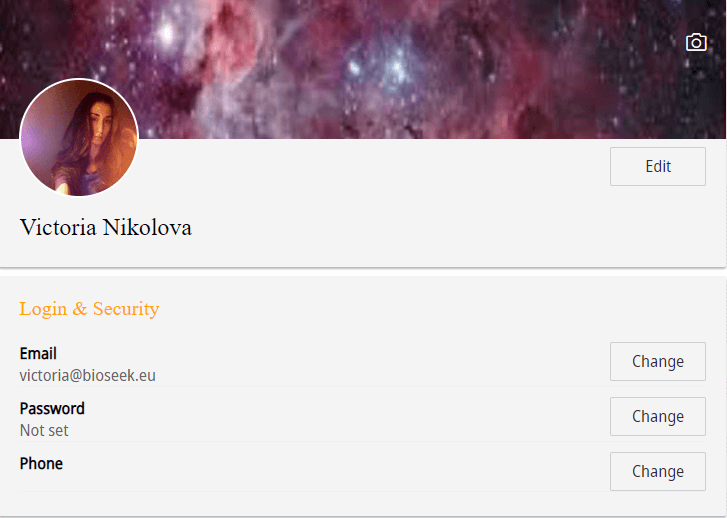
Email settings
Set your preferences about incoming mail.
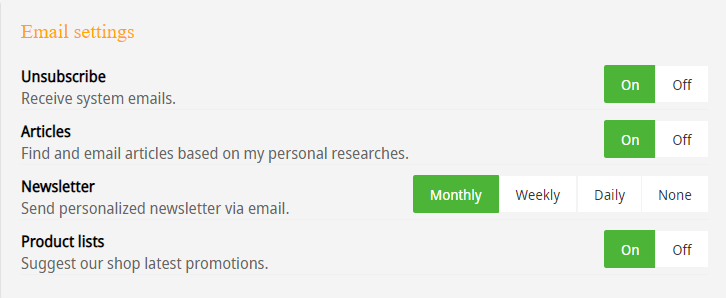
Work
State your positions, if you like.

Copyrights
Claim your publications through an easy guided procedure.
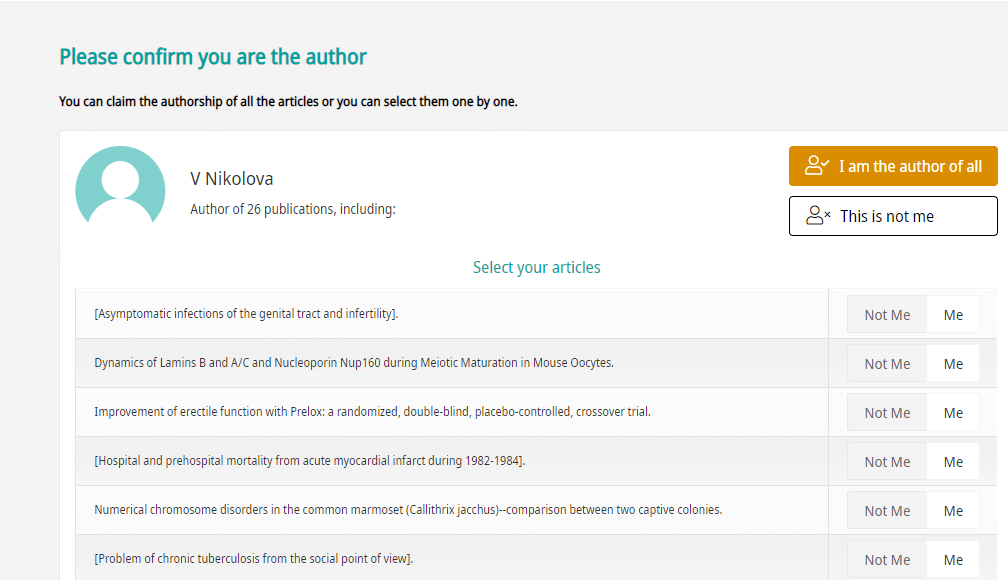
Data usage
State whether and which of your data you would like to be used to customize your newsfeed and to share with others.
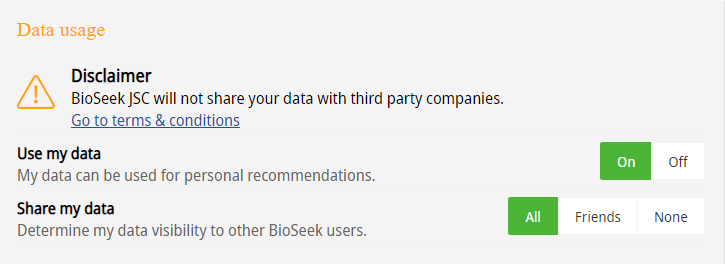
Visibility
State whether you’d like to have your name, email or phone number visible to the public.

History
Set you preferences about storage of searches, viewed items and chat messages.
GDPR
You can delete your profile at any time irreversibly.
You can download your data at any time.
Your personal data is stored in accordance with GDPR's provisions.

Research Module
Basic Search
You search the standard way - just type in text and hit enter.
You can also search using tags, and that has its perks : ) See what they are!
Dynamic Suggest
For any letter you entered in the Search Box BioSeek suggests potential tag matches in a faceted drop list.
If you just hit enter after typing some text it will not be interpreted as a tag, since there might be more than one matching tag per term. You must select the tag from the drop list.
Keyboard Shortcuts
To pick up the desired tag, use Up & Down Arrow and hit ENTER, or click it with the mouse. To switch between tabs in suggestions list, use Ctrl + Left & Right Arrow. As we said, when a tag is selected a box with its name, icon, and color is created in the search box.
Manipulating tag priority to refine your search
When your search contains several search criteria, it is probable that you get scarce results. In this case you have the option to set different priority levels to the tags in your search: required, optional and disabled. This allows you to refine your search without having to delete elements of it. The system always delivers the most complete matches first. When you mark more than 3 tags as optional, one is always treated as required.
BioSeek recognises not only full (canonical) names but also abbreviations, old names, synonyms and aliases of any entity.
BioSeek Cards
Each searchable entity in BioSeek is presented in a card. The card contains structured information about the entity. The information varies depending on the type of entity. For example an article card contains the title and date of publication, a list of the authors (2), and all entities mentioned in the article, represented as icons at the bottom of the card (3). Search criteria by which the article is a match are listed first (1). These lists of related entities are made easily accessible in the Information tab at the right side of the screen - The Right Panel, from where you can navigate further and further, exploring each group of entities to a great extent.
This is an Article Card:
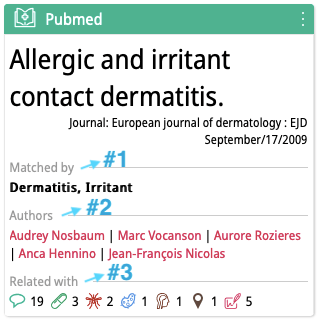
Article card: The card title is the article title, followed by the date of article publication.
- #1 in the screenshot is designated the section which shows the search criteria the article is matching;
- #2 is stating the names of its authors;
- #3 contains icons which designate the types of entities mentioned in this article.
All these information segments, contained in the card, are shown in detail in the Information Tab in the Right Panel, when you click the card.
Pathways are one of the types of entities BioSeek aggregates. The system delivers an interactive pathway image, i.e. you have the option to explore its elements further: the ones highlighted in red are clickable. The magnifier helps you do that comfortably. You have the source link in the Information Tab, so you can navigate directly to the original source.
Right panel
The Right Panel is constantly accessible at the side of your screen. It can be expanded and collapsed. It has four tabs:
- Information
- Chat
- Favorites
- History
Drag-Drop
All cards and tags in BioSeek are drag-droppable. You can drop an entity to the search, to the chat, to the Favorites section etc. The items in your Favorites section can be applied, by drag-drop as well, to create Visual Searches and Mind Maps. You can also drag and drop items from Information, History, Favorites, and Messenger to the search box. Drag-and-drop is a main operational action in BioSeek, as we aim create the easiest, most efficient proceedings.
Sorting of results
By default, sorting is set to best match to search criteria but you can select an additional filter:
- by date published
- by date published
- by number of citations, or
- by number of mentioned entities:
- genes
- diseases
- drugs
- pathways
- organisms
- enzymes
History
Тhe special thing about the BioSeek History section is that, again, each entity in it is drag-droppable, which makes it very easy to operate with it whenever necessary - search it again, drop it to Favorites, start a Visual Search or a Mind Map (see “Drag-drop”)
Advanced Search Functionality
Topics
We have developed a three-level categorization, with categories, subcategories and sub-sub- categories. Each topic was carefully selected based on U.S. National Library of Medicine’s Medical Subject Heading (MeSH). This way, you can narrow down your search in the most refined manner.
We are continuously improving the categorization. Currently, you can choose among 26 main topic categories and more than 200 topic subcategories and sub subcategories in the area of Health
Click on "Topics" located on the left of the Search box. Then choose a topic category or a subcategory from the dropdown list that will appear. Type in a keyword or a tag in the search box to continue your search. We will show you only results related to your chosen topic.
Heatmap
When you perform multicomponent searches, containing 3 or more entities (genes, diseases, organisms, drugs, etc.) it is possible that you don’t find any articles, in which all three are mentioned. That is where the Heatmap comes in - it automatically performs searches for articles which mention each possible pair of entities from your original search. The Heatmap is a table consisting of clickable boxes, in which you see the number of articles mentioning each respective pair of searched items. The darker the color of given box, the larger the number of matching articles.
When you click a box the corresponding articles are presented to you below the Heatmap and you can explore them further by clicking on the cards, as you already know.
When you select the box matching search tags A and B the rest of the search tags in your original search are automatically disabled. To use the Heatmap, you must search at least 3 entities.
View Analytics
Here’s a potential use case: you are searching for articles, mentioning Multiple Sclerosis and the genes HLA-DRB1 and HLA-DQB1 and you want to know which other gene is mostly associated with these three entities. You enter these tags in the search box, you click “ANALYTICS” and, listed below, in the gene section, you see that this is the gene HLA-DQA1, which is mentioned in 18 (number in parenthesis) articles together with Multiple Sclerosis and the genes HLA-DRB1 and HLA-DQB1.
To make it easier for you to quickly spot the most relevant results we implemented faceted representation of search results. We already mentioned in the Dynamic Suggestions explanation. This grouping of results into sets is also applied in the ANALYTICS, only in this case we have one more dimension - the entity additional to those in your search. It can be a gene, a disease, a drug, a process, an author, etc.
In the screenshot below we see (highlighted) that there are 184 genes (number in parenthesis) which are co-mention with Allergic Contact Dermatitis AND, the gene FLG has 11 publications which mention it and Allergic Contact Dermatitis. There are 1692 diseases co-mentioned with Allergic Contact Dermatitis. If we click “Diseases”, we’ll see all of them listed, with corresponding number of articles in parenthesis

BioSeek scans millions of articles and pulls out all those which mention both your initial search criteria AND the entities, listed in the grid.
*To update results to match newly added tags, click “REFRESH”
Charts
You want to know when the peak of mentions of given gene was, or who the most popular author to write about it is, who has written on given topic most recently, or who was the first to write about something? BioSeek can generate for you a Timeline Analysis and a Volume Analysis to visualize the number of mentions of each entity in the articles in our database, in different moments or periods of time.
Timeline Analysis
The Timeline Analysis shows all publications which mention the search tags you have entered AND also mention the selected entity, in the year they were published.This GIF shows you how it works:
Volume Analysis
The Volume Analysis it is focused on the top hits - the 20 most mentioned entities, and can be retrieved year by year as well.
Alert
You can set an alert on your search to have BioSeek notify you via email about any new matching results. You can set the notification frequency to daily, weekly or monthly, which means that BioSeek will automatically re-run your query at these periods and send you emails with updated results.
You can also re-execute the search, or copy it to send the link to someone.
Visual search
The Visual Search allows you to run multicomponent queries.
By drag-dropping the search boxes from the menu on the left side of the screen you can choose the types of entities you are going to search, and draw between them the connections that interest you. You have control over further specifying the entities in each position (search box) and re-execute the query.
Mind Map
The Mind Map is a visualization tool which helps you structure your idea. You can drag-drop any entity to it, and draw a connection you suspect exists or you search for, in order to have your idea visualized in a most clear, full and accurate way. The Mind Maps are shareable. You can set the privacy levels to each map as you wish.
The “Find links” functionality retrieves for you hidden links between the elements in your Mind Map. It is a great tool to help you perform exploratory searches. And so is the Visual Search section
Insights - your dashboard and relevant articles feed
Gain more insight with the detailed overview of your activity and the corresponding article suggestions which can inform your work in particular.
Dashboard
BioSeek delivers various stats at the Insights section to give you a clear overview over your activity: searches and viewed items count and percentages, sent messages, etc. You have sorting options and all items are clickable.
Relevant Articles
Receive Suggestions
We believe that relevant information should find you and not the other way around. Based on your actions and professional profile, BioSeek’s machine learning algorithm intelligently creates a selection of relevant articles at the Insights Newsfeed section. The more you use BioSeek, the more relevant suggestions you will get.
BioSeek Messenger
The only messenger platform optimized for Life Sciences
- Deep integration with all other components of the platform.
- The semantic algorithm which converts terms into interactive entities (tags) allowing for further navigation, operates within messages, making the information they contain easily accessible.
- Recognizes links from other websites and converts them into interactive entities – shareable, clickable, drag-droppable tags.
- Mathematical formulas and chemical reactions are also drag-droppable and interactive → coming soon.
BioSeek Reader
BioSeek Reader enables you to get additional information on any bio term mentioned in your PDF files, in online sites or even emails- in less than a second. It recognises more than 60 million entities.
The web browser extension brings the analytical power to any web source- a database, an online journal.
BioSeek Reader is available for PDF and Outlook as well. Download links below:
BioSeek reader
Detect entities in PDF documents
Browser extension
Detect entities in texts you read online
Outlook add-in
Detect entities in your emails
Translation
Bioseek is using a paid service to deliver automatic translation.
BioSeek has no responsibility regarding the validity of the text, produced as a result of automatic translation. Please, keep in mind that the text delivered to you through automatic translation may not be completely correct and may not correspond fully to the meaning of the original text.
Since the service is paid you have a personal translation quote of up to 80 000 symbols per day.
In case you’d like to have your quote increased, you are welcome to contact us at office@bioseek.eu.
If we already have translated for another user the article you are reading to the language you have selected, your daily quota will not be decreased.
You can select a destination language from the language settings of your profile. In this case the titles of all articles, patents, grants, and clinical trials.
You can translate each article independently, too.
- already translated texts do not decrease your daily limit
- titles are automatically directly translated in case you have selected language to translate to from the language settings of your profile
Shop
Coming soon
Lab
Coming soon



